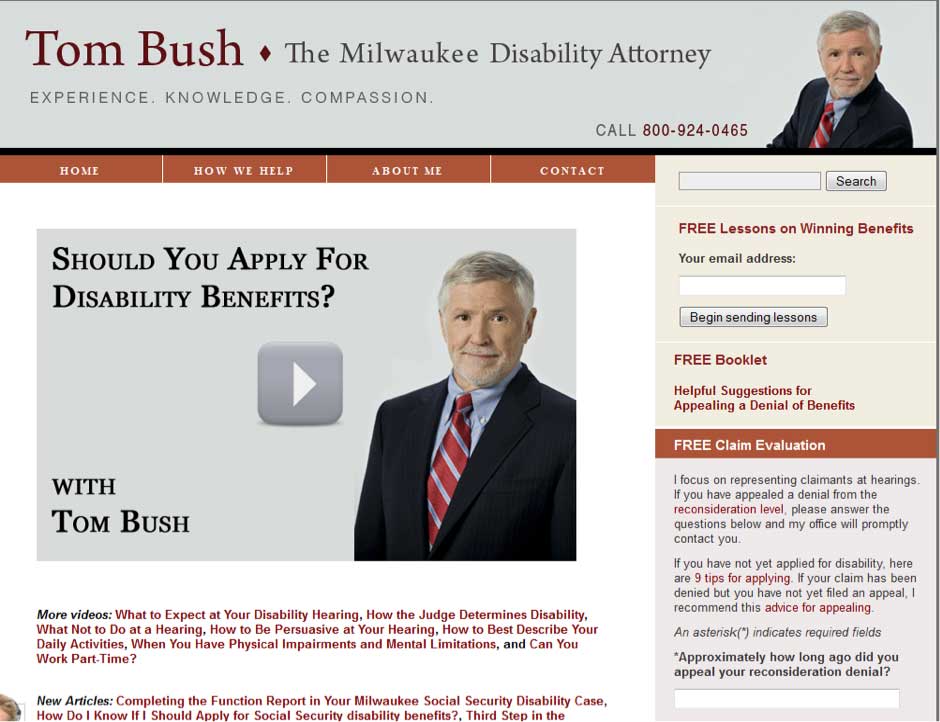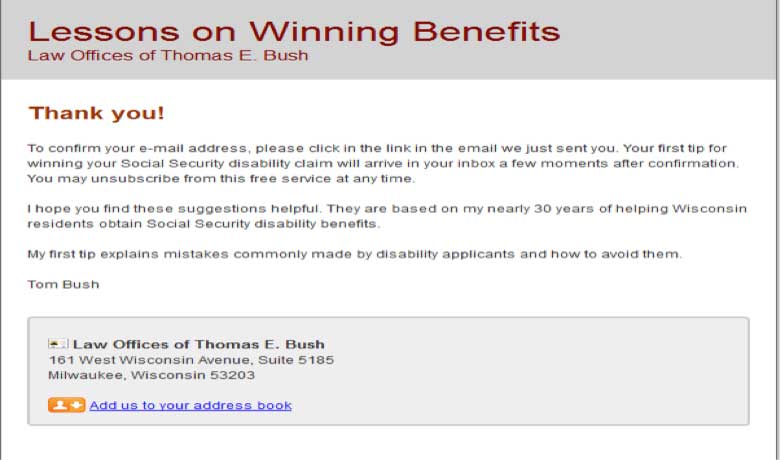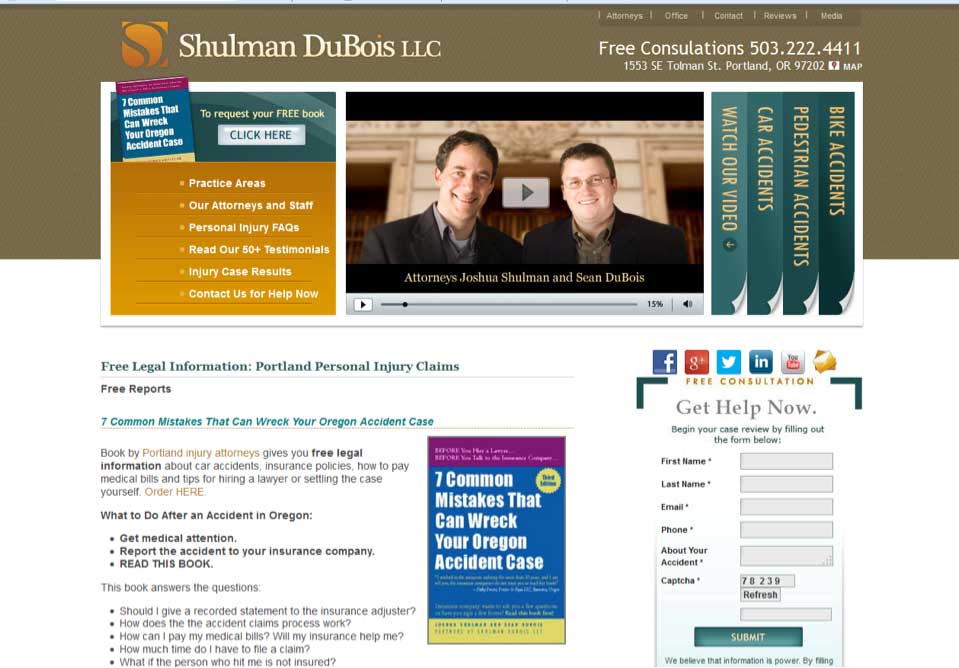Most firms serving consumers can materially raise their prospect-conversion rates by adopting several straightforward steps. Here is the list.
In many ways, client relationships are no different than any other valued relationship. They require time, energy and effort, right from the start. Getting a lead is just the first step in obtaining a new client.
If you are having trouble converting prospective clients into actual clients, you are not alone. It is a frustratingly common experience for many lawyers. The phone is ringing and inquiries are coming in through your website, but too many of these contacts are “one and done.” Why? Lack of attention. Too few lawyers put their prospects into what some call a “nurture” program, even though the practice is standard among smart business marketers.
What Is a Nurture Program?
A nurture program is a means of transforming potential clients into actual clients through frequent and regular communication. The nuts and bolts of a nurture program can take many forms, but the underlying principle is always the same: Reach out to prospective clients regularly, and always provide something of value. Your goal, with each contact, is to establish your credibility and build trust; it is not to sell your services or close the deal. For most people, hiring a lawyer is a big decision, not a snap judgment; it requires careful consideration and deliberation. By providing something of value and nurturing the relationship over a period of time, you gain “mindshare.” This way, when the prospective client is ready to retain an attorney, you will be his first call.
What Do You Need To Develop a Nurture Program?
An effective nurture program requires four things:
- A list of prospective clients;
- A means of regularly contacting your list;
- Something of value to offer your list; and
- Perseverance (and patience).
1. A List of Prospective Clients
Every person who contacts your office – by phone or email or through your website – is a potential client who belongs on your list. Your prospect list should be fluid, and should grow over time. At some point, you may want to make two lists – one for new or “hot” prospects you want to contact more frequently – and one for prospects who have been on your list for some time, who you will reach out to less often (sometimes called a “drip” list). Bottom line: Every inquiry has the potential to become a valuable client, if you stay in touch; thus, every inquiry about you or your practice belongs on your prospect list.
2. A Means of Regularly Contacting Your List
The most efficient way to establish and maintain a nurture program is to use an automatic response campaign or “auto-responder.” An auto-responder is a program that sends an email to a prospective client based on a trigger you choose. The trigger may be action-based or time-based. An action-based responder sends an email when the prospective client takes a specific action. For example, every person who subscribes to your blog receives a “Welcome” email; every person who submits a “Do I Have a Case Form” automatically receives a “Thank you for your inquiry” email, along with an attachment outlining the “Five Things You Can Do Now to Help Your Case.” A time-based responder is useful for sending a series of emails after a particular event has occurred (e.g., a series of educational emails, sent on the second, fifth and tenth day after a prospective client submits the “Do I Have a Case” form).
Building a client relationship takes time and effort, both of which may be in short supply while you are busy juggling your caseload and your personal life. Still, the fact is, the longer you take to respond to an initial inquiry, the more time you give that prospect to move on to someone else. An automated response campaign is, thus, an essential tool in any nurture program. It lets you engage every prospective client and ensures that no prospect is ignored or slips through the cracks.
A good auto-responder works as follows:
To obtain free lessons on obtaining disability benefits, all a prospective client has to do is enter his email address here:

Moments later, the prospective client receives this email, followed by his first lesson:

A number of applications run auto-responder campaigns, including:
- GetResponse – www.GetResponse.com
- AWeber – www.aweber.com/
- MailChimp – www.mailchimp.com
- Constant Contact – www.constantcontact.com
- Infusionsoft – www.Infusionsoft.com
All of the sites above offer a free trial (or nearly free — $1 at AWeber) and provide step-by-step instructions for getting started.
With Direct Mail
While an automated response campaign is an essential component of any successful nurture program, it should not be the only component. The best nurture programs also include a direct mail element.
Because fewer lawyers and businesses of any type now use the U.S. Postal Service, direct mail helps you stand out from the crowd. Plus, for some types of content, direct mail can be even more effective than email. Consider newsletters, for example. Sent by email, a newsletter easily can be deleted, without being opened, or can go straight to a recipient’s “Junk” folder (only to be deleted later). A newsletter that arrives by mail, and presents with a bold headline and bright colors, is much more likely to be opened and read, and maybe even passed on to a friend or neighbor. Longer content (e.g., multi-page booklets or articles) also may be better received in print, rather than hoping your prospect has the patience to scroll through multiple screens to read the entire piece.
A traditional mailing works best when your “something of value” is something for the prospective client to keep for future reference. For example, a criminal defense lawyer might send a short letter reminding prospective clients of their right to remain silent, along with a business card with specific instructions for how to exercise that right on one side of the card, and the lawyer’s contact information on the other. Likewise, traditional mail service is a good way to reach additional prospects when your “something of value” includes one to keep and one to give away. For example, a personal injury lawyer might send a prospective client a “Glove Box Guide,” with step-by-step instructions for what to do after an accident, along with an extra Guide (or two) to give to a family member or friend.
Your website can be a springboard for your direct mail efforts. Offer to mail a free book or “Insider’s Guide” or other valuable item to prospective clients, in exchange for their contact information (name, street address, email):

Once you have a prospect’s address, use your office calendaring system to remind you to drop something in the mail every so often, e.g., every fourth contact or every couple of months.
By Phone
Email and direct mail are effective means of staying in touch with prospective clients, but a phone call from you – not your staff – can have a more immediate and personal impact. Call prospective clients to check in. Leave a message, including a phone number where you can always be reached. Offer to meet with the prospective client face-to-face.
3. Something of Value to Give to Your List
Frequent contact is essential to nurturing a relationship with a prospective client, but frequent contact by itself is just nagging. You must provide something of value most every time you reach out to a prospective client. If you don’t, prospective clients will quickly learn to delete your emails and toss your postal mailings.
Valuable content is content that proves your expertise, establishes your authority, and builds trust. As you continue to provide this content over time, the prospective client will come to think of you as the go-to person to help with his particular situation. Remember, the goal of nurturing is not to gain a new client now, but to gain mindshare – to get in the prospective client’s head, so that when he is ready to retain a lawyer, or when his friend needs a lawyer, you are the first one who comes to mind. Valuable content is the key to making this connection.
What Type of Content Is Valuable?
Valuable content is content that aims to teach, inform, explain or solve a problem that is relevant to the prospect’s situation. It can take many forms. Some prospective clients may prefer a visual presentation, e.g., a link to a short video on your website:

Other prospective clients may find more value in written content, e.g., an informative blog post or article; a newsletter, pamphlet or short booklet; a checklist or how-to guide. Ideally, you want to send a variety of content in a variety of different formats. This will give you a better chance of appealing to a wider range of prospective clients and personalities.
Let’s look at some specific examples of valuable content that a personal injury lawyer might send to prospective clients.
Example: Initial follow-up letter to a prospective client
Here is a sample of a letter that our personal injury attorney might send shortly after his initial contact with the prospect. Notice how the letter provides value (answers common questions; teaches the prospective client how to be proactive about her situation); includes an understated call to action (an offer for a free, in-person consultation – another “something of value”); and promises more valuable information to come. Notice, too, how the letter does not talk about the lawyer’s education or glowing peer reviews or recent court victories. The letter is focused on the prospective client and aims to provide information that is relevant to his situation.
Dear ____,
Thank you for talking with me yesterday. I know you’re going through a difficult time now, and I appreciate you sharing part of your day with me. I hope our conversation was helpful.
As we discussed, no one ever expects to be injured in an accident. The resultant shift in your normal daily routine is sudden and more than a little unsettling. My clients have told me that the first few [weeks/months] following their accident were particularly stressful because they had so many unanswered questions and so little control over the situation that had been thrust upon them.
If this is how you are feeling, I have enclosed a couple of items that I hope will help:
(1) Personal Injury FAQs: Get the Answers You Need to Safeguard Your Legal Rights; and
(2) How to Increase the Value of Your Case by Keeping a Symptom Diary.
The FAQs Booklet answers the questions I am asked most often in the early stages of a personal injury case. It tells you what you must do and what mistakes you must avoid to preserve the full value of your case. The Symptom Diary sheet explains how the simple act of recording your symptoms can increase the value of your case and give you a powerful voice in its final outcome. It also offers specific tips for how to make your diary work for you.
If you have questions about either of these items or about your personal situation, please call or email me. You can reach me directly, at ###-####. I will be happy to talk with you. I may not be available immediately, as I am frequently in court or taking a deposition, but if you leave a message, I will call you back within [an hour or two in most cases].
When you are ready, I will be pleased to schedule a free face-to-face consultation at which I will answer all your questions, review your medical bills and photos, and explain how the insurance company will evaluate your claim.
I also have more helpful information about personal injury claims that I will be sending you shortly.
I wish you well.
[Attorney]
The attachments referred to in this letter are good examples of how to provide varied and valuable content.
Example: How to Increase the Value of Your Case by Keeping a Symptom Diary.
This piece is relatively short (about 700 words; one page, front and back) and provides the prospective client with valuable, use-it-today information.
How to Increase the Value of Your Personal Injury Claim
By Keeping a Symptom Diary
Prepared by
[Attorney]
[Contact Information]
Regardless of how you were injured, there is one easy way to increase the value of your case: Keep a symptom diary.
What is a symptom diary?
A symptom diary is a means of regularly recording the symptoms you are experiencing as a result of your injuries. It can take many forms, including a traditional, handwritten diary; a spiral notebook; a computer log; a spreadsheet; or even a wall calendar with detailed notes.
How will keeping a symptom diary help my case?
Keeping a symptom diary will help your case in two ways:
(1) Proving non-economic losses. In order to obtain compensation for the harm done to you, you must prove that you were, in fact, harmed. Your medical bills, employment records, and receipts for out-of-pocket expenses will help to establish your economic losses. A symptom diary will help to establish your pain and suffering, your loss of enjoyment of life, and other non-economic losses that are harder to quantify.
(2) Filling gaps in your memory. It may take many months to resolve your personal injury claim with the insurance company, and longer if a lawsuit must be filed. Even if you have an excellent memory, your claim for compensation will be stronger if you have a detailed, written record to support and enhance your recollection.
What should I include in my symptom diary?
There are no magic words or phrases you are required to use. There are, however, a couple of ground rules you must follow:
(1) Be honest. Don’t exaggerate your symptoms. If you had a good day, say so. On the other hand, if you had a lousy day, don’t minimize it. Your diary is not the place to be stoic and suffer in silence.
(2) Be specific. A detailed symptom diary is a persuasive symptom diary. For example, do not write simply, “My back hurt all day.” Instead, describe the nature of your pain and how it impacted your day. For example:
- How did you feel when you first woke up in the morning? Were you able to get out of bed, attend to your personal hygiene, and get dressed on your own?
- What was your pain level, on a scale of 1-10? Where was the pain located? Did it radiate? Did it subside or increase as the day progressed?
- Did you take any medication for the pain? Did the medication have side-effects (e.g., drowsiness, irritability, nausea)?
- Did you take any other steps to alleviate the pain (e.g., yoga, meditation, physical therapy)? Were those measures effective?
- How did you spend your day? Were you active or did your symptoms keep you in bed?
- Were you able to go to work? Clean the house? Exercise? Do the shopping? Care for your children? Cook dinner for your family?
- Did you fall asleep easily at night? Did you sleep through the night?
The more specific you can be in describing your symptoms – whether to an insurance adjuster; to opposing counsel; or to a jury at trial – the greater your chances of obtaining fair compensation for the harm done to you.
When should I get started?
You can start right now. Choose a format (e.g., a notebook or laptop or wall calendar) that will be easy for you to stick with throughout the life of your claim. Be sure to include the date every time you make a new entry. Try to update your diary at least once a week and when something out-of-the-ordinary happens (e.g., a visit to a new doctor or a trip to the emergency room).
Keep your diary confidential.
Do not show your symptom diary to anyone – especially the claims adjuster for the person or entity that caused your injuries – without first consulting with a personal injury attorney. Keep it private and confidential.
If you have questions about keeping a symptom diary . . .
If you have questions about keeping a symptom diary or about your personal injury case in general, please call me. You can reach me at ###-####. If I’m away from the office on another client matter, be sure to leave a message with my assistant _______, and I will get back to you that same day. If I can’t address your immediate concerns over the phone, we can schedule a free, in-person consultation, at your convenience.
* * *
Example: Personal Injury FAQs: Get the Answers You Need to Safeguard Your Legal Rights
This is an excerpt from a longer piece of content (11 pages). It provides value to the prospective client because it provides answers. Plus, because it is a substantial piece, it will continue to nurture the potential client relationship long after it is first read. Even if the prospect is not ready to retain an attorney now, she can return to this piece for answers – and the attorney’s contact information – later, when she is ready.
Personal Injury FAQs:
Get the Answers You Need to Safeguard Your Legal Rights
Prepared For You By:
[Attorney]
[Contact information]
A thorough understanding of the details of your personal injury case can help you get the best possible outcome. In this booklet, I explain what you should do to maximize the value of your case and what you should avoid so that you do not jeopardize your case. I also answer the questions that most clients have at the outset of the case.
If you have further questions after you read this booklet, please write them down and call me. I will be happy to speak with you. If I’m tied up in court or with a client, be sure to leave a message. I will call you back just as soon as I am free. Or, even better, you can schedule a free no-obligation initial consultation with me. I will be happy to answer all your questions, review your medical bills and photos, and give you my assessment of your case when we meet.
Table of Contents
I. Your #1 Priority: Taking Care of Yourself
II. Paying Your Medical Bills
III. Keeping Track of Your Medical Bills
IV. Working with Your Lawyer
V. Lawyers’ Fees and Costs
VI. The Insurance Companies
VII. The Person, Persons, or Company Who Caused Your Injuries
VIII. Settlement
I. Your #1 Priority: Taking Care of Yourself
Q. What is the most important thing for me to do after my injury?
A. The most important thing for you to do is to recover from your injury. You may be surprised to learn that taking good care of yourself is essential to achieving the highest possible settlement or verdict. The law requires injured people to “mitigate their damages.” In other words, the law requires you to do whatever is necessary to improve your physical condition and recover from your injury.
Q. What, specifically, do I have to do to “mitigate my damages?”
A. For you this may mean some, or all, of the following steps:
Do not miss appointments with your doctor. Stay in touch with your doctor and be certain to keep your appointments. If you have to cancel, give the doctor with as much notice as possible. The words “no show” on a doctor’s record sheet can be used against you at the time of settlement or trial.
Attend physical therapy sessions as prescribed. Your physician or hospital may prescribe therapy to help you recovery from your injury. Physical therapy is often helpful in many types of injuries including strains, sprains, and other so‑called “soft tissue” injuries. If physical therapy is prescribed, be sure to keep your appointments and participate actively in the process. Again, if you have to cancel an appointment, be sure to call, but try to avoid cancellation as much as possible.
Do what your doctor tells you to do. If your physician prescribes certain medications, therapy exercises, or limitations on activities, be sure to follow your doctor’s orders. Failure to follow your doctor’s advice can be used against you when it comes time to settle your case, or can be used against you in court if your claim proceeds to litigation.
Follow your doctor’s advice with respect to work and leisure activities. If your physician advises you to rest, stay home from work, or avoid certain activities, it is important that you follow this advice. If you resist your doctor’s advice and do activities that your doctor has told you to limit, you may prevent your speedy recovery and damage your case. If your doctor advises you to stay home from work, do it. Your lost earnings can be recovered as part of your damages.
II. Paying Your Medical Bills
Q. How do I pay my medical bills?
A. Your lawyer will discuss the payment of your medical bills in detail with you. In summary, your medical bills may be paid by one of the following methods:
- Your own health insurance from your employment benefits package.
- Your own health insurance that you may have paid for personally.
- Health insurance obtained by your spouse for your benefit or by your parents if you are on their insurance.
* * *
The list of valuable items you could send to prospective clients is limited only by the parameters of your practice and your creativity. For example, our personal injury attorney could send a series of emails and letters, along with short booklets, information sheets, or links to videos covering:
- How Insurance Companies Work
- Common Adjuster Ploys and Dirty Tricks
- Factors that Impact Settlement Value
- How Can a Personal Injury Attorney Help Me?
- How to Get the Most Out of Your First Meeting with Your Personal Injury Attorney
- How to Keep Track of Your Medical Bills and Expenses
- How the Adjuster Will View Your Claim
Each of these items would provide valuable information to help the potential client deal with a particular aspect of a personal injury case and would plainly demonstrate the attorney’s knowledge, experience and expertise.
Look to Outside Sources
You may be thinking, “I don’t have time to create all this valuable content.” Worry not. You don’t have to create all your content yourself. You can establish your authority and build trust by showing that you are on top of the issues that may affect the prospective client’s case. Here are some easy ways to do that:
- Send a prospective client a short email to let her know about “a recent trend that has the potential to impact” her situation, along with a link to a relevant article or series of articles and an offer for a free consultation.
- Alternatively, mail a copy of an article to prospective clients, along with a short letter or Post-It Note that reads, “I thought you might find this interesting. If you have questions, please call me.”
- Send an “In the News” email, with links to events or articles relevant to the potential client’s situation.
5. Perseverance (and Patience)
How often should you contact a prospective client? How long should you continue to nurture the relationship?
The answers to these questions depend on the nature of your practice and the urgency of the potential client’s situation. Thus, for example, a potential client who is dealing with serious injuries or a possible criminal investigation likely will have a greater sense of urgency to his search for an attorney than will a person inquiring about estate planning.
As a general rule, you want to front-load your communications, so that you reach out to your prospects more frequently in the early stages of the nurturing process. For example, you might decide to contact new prospects within 24 hours of their initial inquiry, and to reach out again three days, five days, and ten days after that initial inquiry. Thereafter, your contacts may slow to once or twice monthly for a period of time.
As time passes, the frequency of your contact may be reduced to a drip, but the quality of your content and the value of your contact always should remain high. So, for example, rather than reaching out every couple of weeks, you might send a quarterly newsletter; or an occasional Special Bulletin explaining how a recent court decision impacts the potential client’s situation; or a holiday card, along with an article summarizing important new laws that take effect after the first of the year and offering a free consultation.
In general, as long as you continue to provide valuable content, you can continue to nurture the potential client relationship. Your potential client may not need an attorney in the immediate future, but his neighbor or his sister-in-law might. If you have established your credibility and nurtured trust, you may get a referral and the opportunity to nurture a new potential client relationship.
In Sum
In sum, a successful nurturing program requires that you:
- Maintain regular contact with prospective clients with the help of an auto-responder email program.
- Always provide something of value. The goal of every contact is to teach, inform, explain, or solve problems; it is not to sell.
- Mix it up. Send a variety of valuable content in a number of different formats, e.g., links to videos or your blog; direct mail newsletters; laminated checklists; articles written by you; articles written by others; summaries; booklets and special reports.
- Be patient. Nurturing a client relationship takes time. Your potential clients (i.e., anyone who reaches out to you, through your website or otherwise) may be bound by a statute of limitations, by the urgency of their situation, or by the quirks of their personality, but they certainly are not bound by your schedule.
- Be persistent. The whole point of your nurturing program is to stay in touch – to get in the prospective client’s head – so that when he is ready to hire a lawyer, you are the first lawyer who comes to mind.





1 Comment
Extra resources https://1xslots-brasil.site